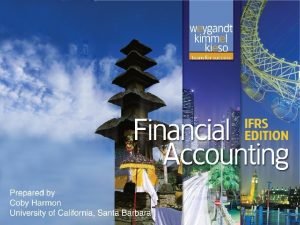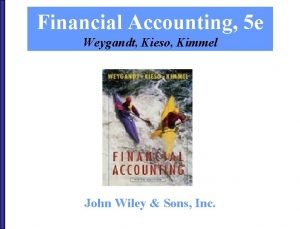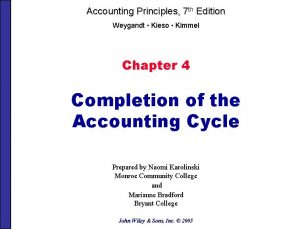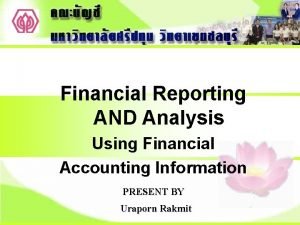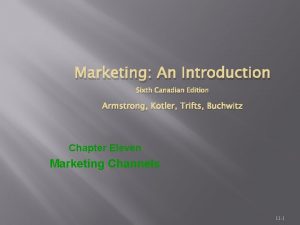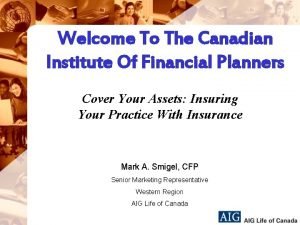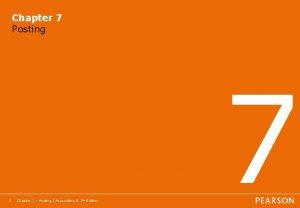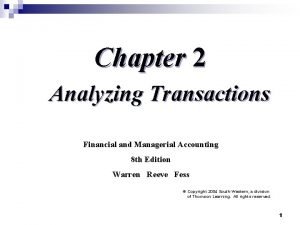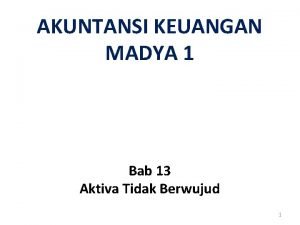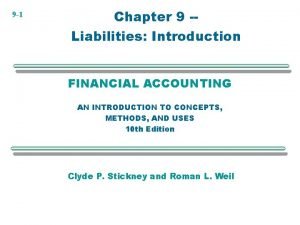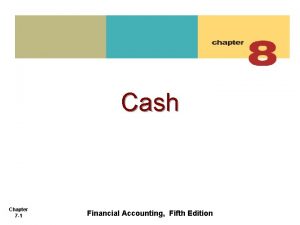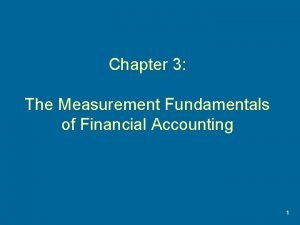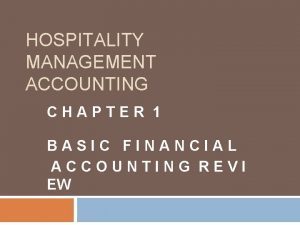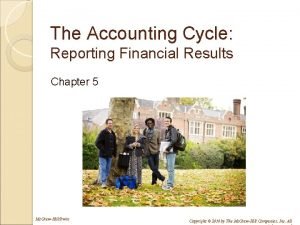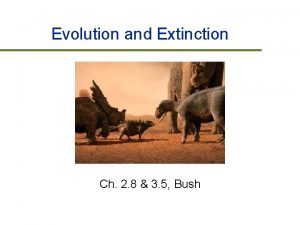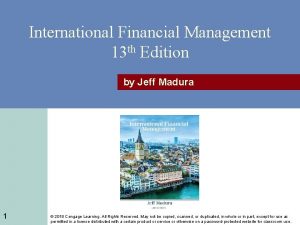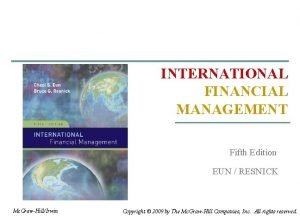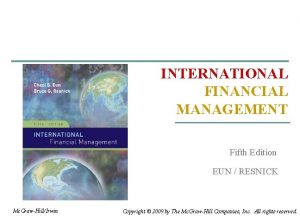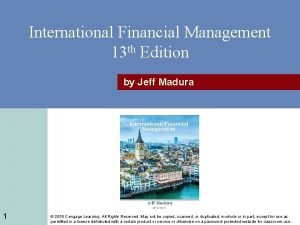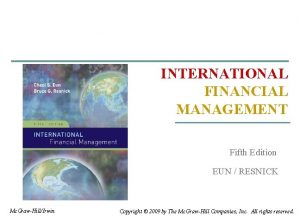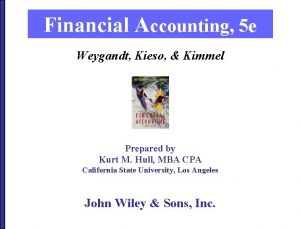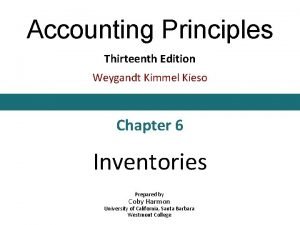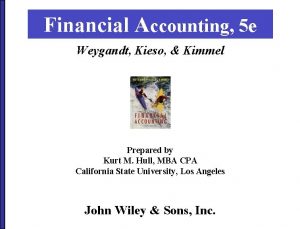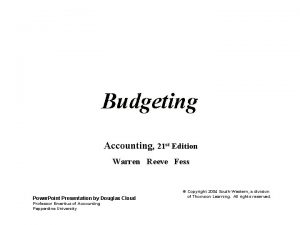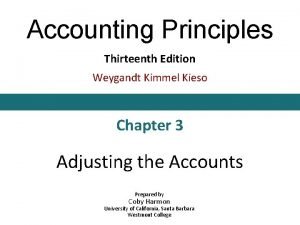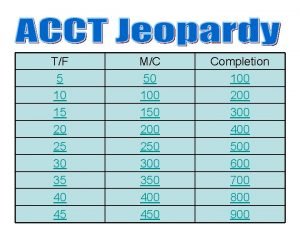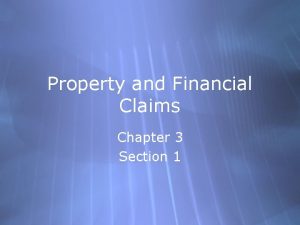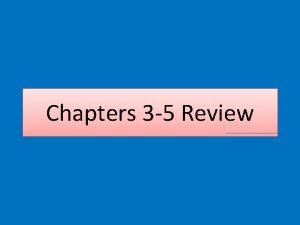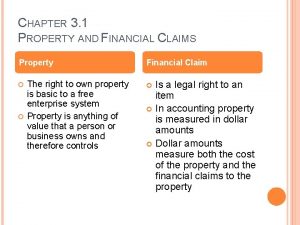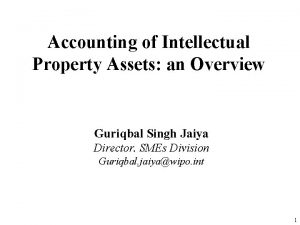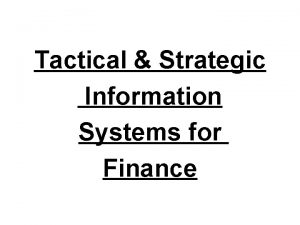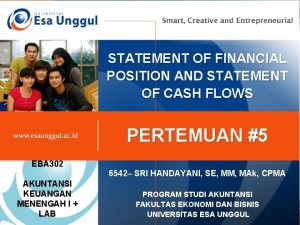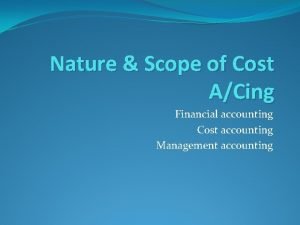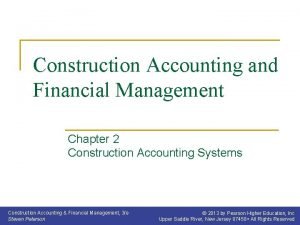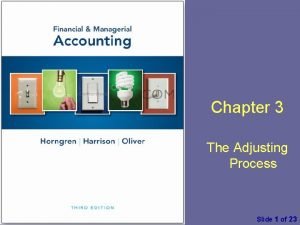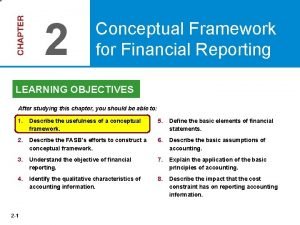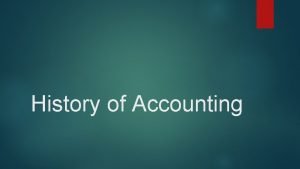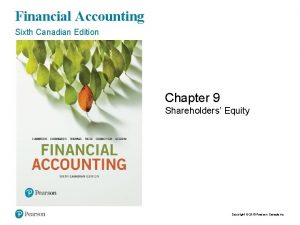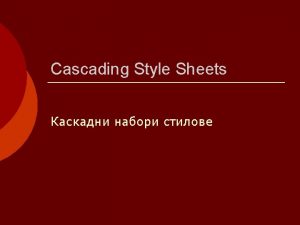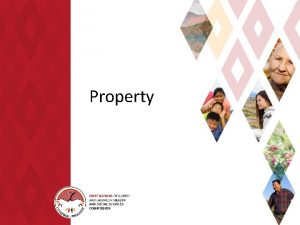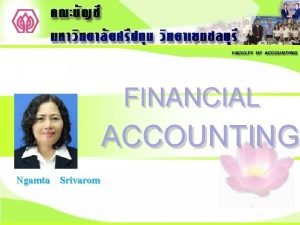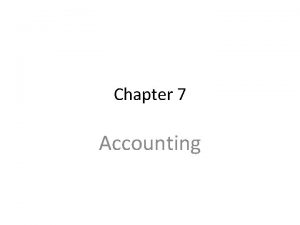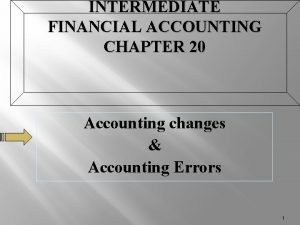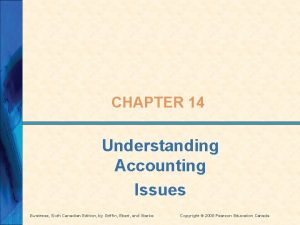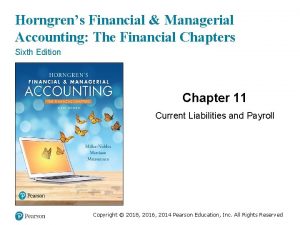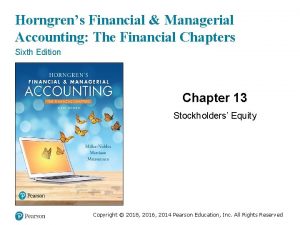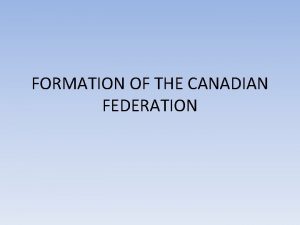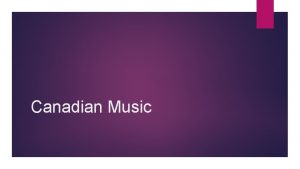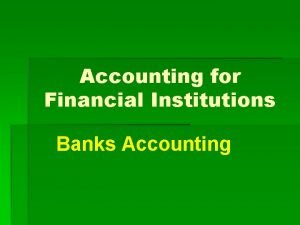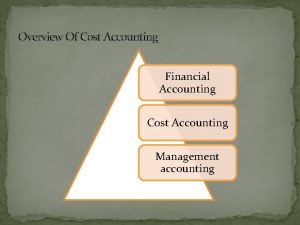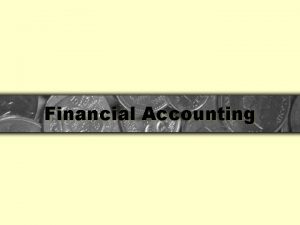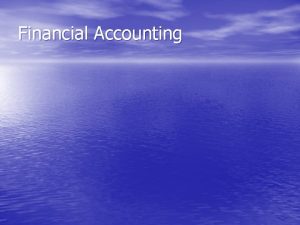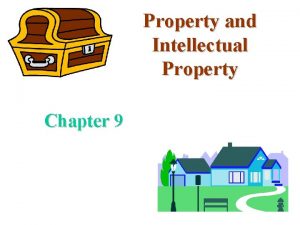Financial Accounting Sixth Canadian Edition Chapter 6 Property



































































- Slides: 67

Financial Accounting Sixth Canadian Edition Chapter 6 Property, Plant and Equipment, and Intangible Assets Copyright © 2018 Pearson Canada Inc.

Learning Objective One Measure and account for the cost of property, plant and equipment Copyright © 2018 Pearson Canada Inc.

Long-Lived Assets (1 of 2) Asset Account (Balance Sheet) Related Expense Account (Income Statement) Tangible assets Land None Buildings, Machinery, & Equipment Depreciation Furniture and Fixtures Depreciation Computers Depreciation Copyright © 2018 Pearson Canada Inc.

Long-Lived Assets (2 of 2) Asset Account (Balance Sheet) Related Expense Account (Income Statement) Intangible assets Copyrights Amortization Patents Amortization Goodwill Impairment losses Copyright © 2018 Pearson Canada Inc.

Measuring the Cost of a PPE Asset Sum of all costs incurred to bring the asset to its location and intended use Copyright © 2018 Pearson Canada Inc.

Land (1 of 3) • Purchase price • Commissions • Survey & legal fees • Back property taxes paid • Grading and removing unwanted buildings Copyright © 2018 Pearson Canada Inc.

Land (2 of 3) A business signs a $300, 000 note payable to purchase land for a new production facility. It pays $10, 000 in real estate commission, $8, 000 in back property tax, $5, 000 for removal of an old building, a $1, 000 survey fee, and $260, 000 to pave the parking lot. What is the cost of the land? Copyright © 2018 Pearson Canada Inc.

Land (3 of 3) • Purchase price of land $300, 000 • Add related costs: • Real estate commission • Back property tax 8, 000 • Removal of buildings 5, 000 • Survey fees 1, 000 • Total cost of land $10, 000 24, 000 $324, 000 Copyright © 2018 Pearson Canada Inc.

Buildings • Constructed – Architectural fees, building permits, and contractors’ charges – Materials, labor, and overhead – Interest on funds borrowed • Purchased – Purchase price – Broker’s commission – Taxes paid – Costs to repair and renovate Copyright © 2018 Pearson Canada Inc.

Equipment • Purchase price (after discounts) • Transportation • Insurance in transit • Sales and other taxes • Purchase commission • Installation and testing Copyright © 2018 Pearson Canada Inc.

Land Improvements Leasehold Improvements • Parking lots • Improvements to lease property • Driveways • Depreciated or amortized over lease term • Signs • Fences • Sprinkler systems Copyright © 2018 Pearson Canada Inc.

Lump-Sum (Basket) Purchases • Several assets purchased in a group at one price • Total cost is allocated based on their market values Asset Market value Total market value % of total market value Total cost Cost of each asset Land $300, 000 ÷ $3, 000 = 20% × $2, 800, 000 $280, 000 Building $2, 700, 000 ÷ $3, 000 = 80% × $2, 800, 000 $2, 520, 000 $3, 000 100% $2, 800, 000 Copyright © 2018 Pearson Canada Inc.

CAPITAL EXPENDITURES EXPENSES • Increase capacity or extend useful life • Do not extend capacity or useful life • Cost is added to an asset account • Maintain or restore working order • Cost is recorded as an expense Distinction between the two requires judgment Copyright © 2018 Pearson Canada Inc.

Learning Objective Two Measure and record depreciation on property, plant and equipment Copyright © 2018 Pearson Canada Inc.

Depreciation • Allocation of plant asset’s cost to expense over its life • Supports matching principle • Causes: – Physical wear and tear – Obsolescence • Land is NOT depreciated – Unlimited useful life Copyright © 2018 Pearson Canada Inc.

Depreciation is NOT: Valuation process A fund to replace assets Copyright © 2018 Pearson Canada Inc.

Amounts Needed for Depreciation Cost Useful life Residual value Copyright © 2018 Pearson Canada Inc.

Depreciation Methods Straight-line Units-of-production Diminishing-balance Copyright © 2018 Pearson Canada Inc.

Straight-Line (SL) Copyright © 2018 Pearson Canada Inc.

Accumulated depreciation increases Carrying Amount decreases Asset’s final carrying amount = Residual value Copyright © 2018 Pearson Canada Inc.

Units-of-Production (UOP) Copyright © 2018 Pearson Canada Inc.

Double-Diminishing-Balance (DDB) Copyright © 2018 Pearson Canada Inc.

Residual Value: DDB Copyright © 2018 Pearson Canada Inc.

DDB Differences with other methods • First-year depreciation is based on asset’s full cost • Final year depreciation is a “plug” amount needed to reduce carrying amount to residual value Copyright © 2018 Pearson Canada Inc.

Comparing Depreciation Methods (1 of 2) Straight-line • Best for assets that generate revenue evenly Units-ofproduction • Best for assets that wear out because of use Doublediminishingbalance • Best for assets that generate revenue early in useful life Copyright © 2018 Pearson Canada Inc.

Amortization Methods Data Items Amount Cost of van $41, 000 Less: Estimated residual value – 1, 000 Depreciable cost $40, 000 Estimated useful life Units of production 5 years 100, 000 units (kilometers) Copyright © 2018 Pearson Canada Inc.

Straight-Line Method (Cost – Residual value) ÷ Years of useful life ($41, 000 – $1, 000) ÷ 5 = $8, 000 Year 1 depreciation: $ 8, 000 Year 2 depreciation: 8, 000 Year 3 depreciation: 8, 000 Year 4 depreciation: 8, 000 Year 5 depreciation: 8, 000 Total depreciation: $40, 000 Copyright © 2018 Pearson Canada Inc.

Units-of-Production Method ($41, 000 – $1, 000) ÷ 100, 000 = $0. 40/km Year 1: 20, 000 km × $0. 40 = $ 8, 000 Year 2: 30, 000 km × $0. 40 = 12, 000 Year 3: 25, 000 km × $0. 40 = 10, 000 Year 4: 15, 000 km × $0. 40 = 6, 000 Year 5: 10, 000 km × $0. 40 = 4, 000 Total depreciation: $40, 000 Copyright © 2018 Pearson Canada Inc.

Diminishing-Balance Method Straight-line rate per year: 100% ÷ 5 = 20% Double-declining balance: 2 times the straight-line rate = 40% Carrying amount of truck at end of first year: $41, 000 × 40% = $16, 400 $41, 000 – $16, 400 = $24, 600 Copyright © 2018 Pearson Canada Inc.

Comparing Depreciation Methods (2 of 2) Amount of Depreciation per Year SL UOP DDB 1 $ 8, 000 $16, 400 2 8, 000 12, 000 9, 840 3 8, 000 10, 000 5, 904 4 8, 000 6, 000 3, 542 5 8, 000 4, 314 $40, 000 Total Copyright © 2018 Pearson Canada Inc.

Depreciation Patterns Copyright © 2018 Pearson Canada Inc.

Learning Objective Three Explain additional topics in accounting for long-lived tangible assets Copyright © 2018 Pearson Canada Inc.

Depreciation for Partial Years (1 of 3) Copyright © 2018 Pearson Canada Inc.

Depreciation for Partial Years (2 of 3) Suppose a calendar-year business purchases a building on April 1 for $500, 000 with an estimated life of 20 years and an estimated residual value of $80, 000. What is the current year’s depreciation using the straight-line method? Copyright © 2018 Pearson Canada Inc.

Depreciation for Partial Years (3 of 3) Full-year depreciation: ($500, 000 – $80, 000) ÷ 20 = $21, 000 Partial-year depreciation: $21, 000 × 9/12 = $15, 750 Copyright © 2018 Pearson Canada Inc.

Changing Useful Life Copyright © 2018 Pearson Canada Inc.

Changing the Useful Life of a Depreciable Asset (1 of 2) Assume an asset cost of $40, 000, an eight-year useful life with no residual value, and the straight-line method. $40, 000 ÷ 8 = $5, 000 depreciation per year What is the carrying amount after two years? $40, 000 – $10, 000 = $30, 000 Copyright © 2018 Pearson Canada Inc.

Changing the Useful Life of a Depreciable Asset (2 of 2) Management believes the asset will remain useful for an additional ten years. $30, 000 ÷ 10 = $3, 000 (new depreciation per year) Copyright © 2018 Pearson Canada Inc.

Fully Depreciated Assets An asset can be used after it is fully depreciated. The asset and its depreciation account remain in the ledger with no additional depreciation entries. Copyright © 2018 Pearson Canada Inc.

Derecognition of PPE • Derecognition is an IFRS term for PPE that is no longer useful or has been sold. • Bring depreciation up to date to: – Measure asset’s final carrying amount – Record expense up to date of sale • Remove asset and related accumulated depreciation account from books Copyright © 2018 Pearson Canada Inc.

Disposing of Asset for No Proceeds JOURNAL Date Accounts and explanation Debit Credit Accumulated depreciation Equipment Disposed of fully depreciated asset Copyright © 2018 Pearson Canada Inc.

Selling a PPE Asset If cash received is greater than carrying amount GAIN If cash received is less than carrying amount LOSS Copyright © 2018 Pearson Canada Inc.

Accounting for Disposal of Property, Plant and Equipment: Example Fixtures cost: $10, 000 Accumulated depreciation: $ 3, 750 Carrying amount: $ 6, 250 Proceeds of sale > carrying amount, resulting in a gain on disposal. Cash 7, 000 Accumulated Depreciation 3, 750 Gain on Disposal Store Fixtures 750 10, 000 To dispose of store fixtures Copyright © 2018 Pearson Canada Inc.

T-Accounts for Analyzing PPE Example: Suppose you started the year with buildings that cost $100, 000. During the year you bought another building for $150, 000 and ended the year with buildings that cost $180, 000. What was the cost of the building you sold? Building 100, 000 150, 000 Cost of assets sold ? 70, 000 180, 000 Copyright © 2018 Pearson Canada Inc.

Special Issues in Accounting for Property, Plant, and Equipment Long-lived assets are complex because: • Depreciation affects income taxes • Significant components of PPE should be depreciated separately • Assets should be tested regularly for impairment • Revaluation method could be used to measure PPE Copyright © 2018 Pearson Canada Inc.

Depreciation for Tax Purposes Many businesses use the straight-line method for reporting property, plant and depreciation expense on the income statement. The Income Tax Act permits taxpayers to use accelerated depreciation (up to specified CCA maximums) for tax purposes. Copyright © 2018 Pearson Canada Inc.

Depreciating Significant Components IFRS require that significant components of an item of property, plant, and equipment be depreciated separately. Copyright © 2018 Pearson Canada Inc.

Impairment (1 of 2) At each reporting date, a company should review its property, plant, and equipment to see if an asset is impaired. Impairment occurs when the carrying amount exceeds its recoverable amount. Impairment may be caused by many factors including obsolescence, physical damage, and loss in market value. Copyright © 2018 Pearson Canada Inc.

Impairment (2 of 2) Loss on Impairment Accumulated Depreciation XXX If the situation changes, IFRS does permit a company to reverse the impairment loss by writing the asset up to its carrying amount. Copyright © 2018 Pearson Canada Inc.

Revaluation Model Under the revaluation model, the asset is recorded at cost when purchased but then measured at its fair value less any accumulated depreciation less any accumulated losses. Fair Value the price at which the asset could be sold Copyright © 2018 Pearson Canada Inc.

Learning Objective Four Account for intangible assets Copyright © 2018 Pearson Canada Inc.

Intangible Assets • No physical form – Carry special rights – Include patents, copyrights, and franchises • Two categories – Finite lives § Amortization recorded – Straight-line method usually used, but… – Other amortization methods are allowed – Indefinite lives § Tested for loss in value (impairment) Copyright © 2018 Pearson Canada Inc.

Accounting for Specific Intangibles Patents Copyrights Franchises and licenses Trademarks and trade names Goodwill Copyright © 2018 Pearson Canada Inc.

Patents • Granted by federal government • Give holder exclusive right to produce and sell an invention • Last 20 years Copyright © 2018 Pearson Canada Inc.

Intangible Assets: Patents January 1 Patents 170, 000 Cash 170, 000 To acquire a patent December 31 Amortization Expense Accumulated Amortization 34, 000 To amortize the cost of a patent Copyright © 2018 Pearson Canada Inc.

Copyrights • Granted by the federal government • Give holder exclusive rights to reproduce and sell a book, musical composition, film, or other work of art • Extend 50 years after creator’s life – Useful life is usually very short © Copyright © 2018 Pearson Canada Inc.

Trademarks and Trade Names • Distinctive identification of a product or service – Also include advertising slogans • Useful life may be set by contract – Or indefinite life • Indicated by TM or ® Copyright © 2018 Pearson Canada Inc.

Franchises and Licenses • Granted by private business or government • Give purchase right to sell a product or service with specified conditions • Include restaurant chains and sports organizations • Have indefinite life Copyright © 2018 Pearson Canada Inc.

Goodwill • Only recorded when an entire company is purchased • Defined as the excess of the purchase price of the company over the market value of its net assets • Represents earning power of company purchased • Not amortized Copyright © 2018 Pearson Canada Inc.

Intangible Assets: Goodwill Example Canadian Tire’s Purchase of Forzani Group (FGL) All in million $ FGL’s assets at market value $1, 149. 9 Less: FGL’s liabilities 657. 7 Market value of FGLs net assets 492. 2 Purchase price paid for(FGL) $ 800. 6 Goodwill ($800. 6 − $492. 2) $ 308. 4 Copyright © 2018 Pearson Canada Inc.

Asset Impairment • Both tangible and intangible assets must be tested yearly for impairment • Occurs when expected future cash flows less than asset’s carrying amount • Carrying value adjusted to fair value Copyright © 2018 Pearson Canada Inc.

Research and Development Research costs must be expensed when incurred. Development costs meeting certain criteria must be capitalized. Copyright © 2018 Pearson Canada Inc.

Learning Objective Five Analyze a company’s return on assets Copyright © 2018 Pearson Canada Inc.

Return on Assets (ROA) (Beginning total assets + Ending total assets)/2 Copyright © 2018 Pearson Canada Inc.

Learning Objective Six Analyze the cash flow impact of long-lived asset transactions Copyright © 2018 Pearson Canada Inc.

Long-Lived Asset Transactions on the Cash Flow Statement Item Section Description Depreciation and amortization Operating Added to net income as a reconciling item Sales of long-lived assets Investing Cash proceeds from sales of plant assets (inflow) Acquisition of long-lived assets Investing Cash purchases (outflow) Copyright © 2018 Pearson Canada Inc.

End of Chapter Six Copyright © 2018 Pearson Canada Inc.
 Accounting principles second canadian edition
Accounting principles second canadian edition Accounting principles second canadian edition
Accounting principles second canadian edition Accounting principles second canadian edition
Accounting principles second canadian edition Accounting principles second canadian edition
Accounting principles second canadian edition Peter piper tongue twister
Peter piper tongue twister The sixth sick sheik's sixth sheep's sick lyrics
The sixth sick sheik's sixth sheep's sick lyrics Financial accounting ifrs 4th edition chapter 12
Financial accounting ifrs 4th edition chapter 12 Financial accounting chapter 1
Financial accounting chapter 1 Kimmel accounting tools 5e
Kimmel accounting tools 5e Kimmel financial accounting 7the edition
Kimmel financial accounting 7the edition Using financial accounting information 10th edition
Using financial accounting information 10th edition Biochemistry sixth edition 2007 w.h. freeman and company
Biochemistry sixth edition 2007 w.h. freeman and company Computer architecture a quantitative approach sixth edition
Computer architecture a quantitative approach sixth edition Automotive technology principles diagnosis and service
Automotive technology principles diagnosis and service Automotive technology sixth edition
Automotive technology sixth edition Citation sample pdf
Citation sample pdf Computer architecture a quantitative approach 6th
Computer architecture a quantitative approach 6th Precalculus sixth edition
Precalculus sixth edition Rational people think at the margin
Rational people think at the margin Computer architecture a quantitative approach sixth edition
Computer architecture a quantitative approach sixth edition Marketing an introduction 6th canadian edition
Marketing an introduction 6th canadian edition Sujata madan
Sujata madan Fundamentals of corporate finance third canadian edition
Fundamentals of corporate finance third canadian edition Advanced corporate accounting ppt
Advanced corporate accounting ppt Canadian institute of financial planners
Canadian institute of financial planners Accounting 1 7th edition chapter 7
Accounting 1 7th edition chapter 7 Using mis 10th edition
Using mis 10th edition Chapter 1
Chapter 1 Chapter 2 solutions managerial accounting
Chapter 2 solutions managerial accounting Financial accounting chapter 13
Financial accounting chapter 13 Accounting chapter 6
Accounting chapter 6 Financial accounting chapter 9
Financial accounting chapter 9 Financial accounting chapter 7
Financial accounting chapter 7 Financial accounting chapter 3
Financial accounting chapter 3 Accounting chapter 2
Accounting chapter 2 Hotel management accounting
Hotel management accounting Financial accounting chapter 5
Financial accounting chapter 5 Commutative vs associative
Commutative vs associative Classification of property under hindu law
Classification of property under hindu law Physical property and chemical property
Physical property and chemical property Modes of speciation ppt
Modes of speciation ppt International financial management jeff madura ppt
International financial management jeff madura ppt Expanded opportunity set international finance
Expanded opportunity set international finance Objectives of international finance
Objectives of international finance International financial management 13th edition
International financial management 13th edition International financial management 5th edition
International financial management 5th edition Kimmel weygandt kieso accounting 5th edition
Kimmel weygandt kieso accounting 5th edition Accounting principles 13th edition
Accounting principles 13th edition Kimmel weygandt kieso accounting 5th edition
Kimmel weygandt kieso accounting 5th edition Warren reeve fess accounting edition 21
Warren reeve fess accounting edition 21 Accounting principles 13th edition
Accounting principles 13th edition If the creditors financial claim to property totals $1 000
If the creditors financial claim to property totals $1 000 What is financial claim
What is financial claim All of the following account titles are asset titles except
All of the following account titles are asset titles except Property claim
Property claim Sfas 142
Sfas 142 Non-financial methods of motivation
Non-financial methods of motivation Tactical accounting and financial information system
Tactical accounting and financial information system Statement of financial position
Statement of financial position Scope of management accounting is
Scope of management accounting is Nature and scope of cost accounting
Nature and scope of cost accounting The nature of management accounting
The nature of management accounting Construction accounting terms
Construction accounting terms Income statement in financial accounting
Income statement in financial accounting Unit 5 lesson 2 financial accounting
Unit 5 lesson 2 financial accounting Unit 5 lesson 2 financial accounting
Unit 5 lesson 2 financial accounting Conceptual framework for financial accounting
Conceptual framework for financial accounting Father of accountancy
Father of accountancy






